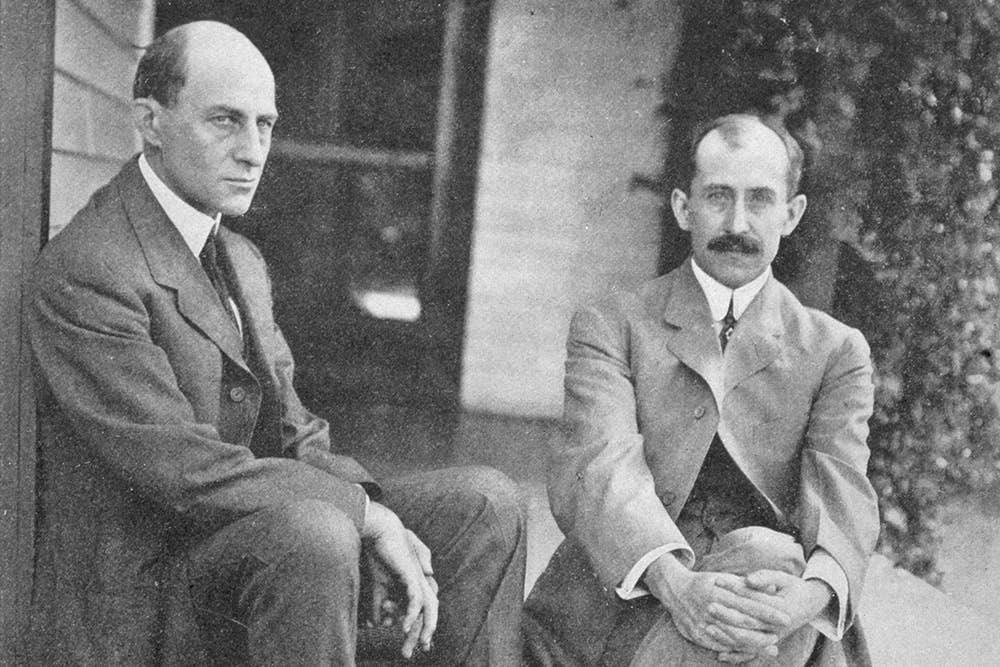Celebrating a Day Full of Aviation History
The Wright brothers’ first flight isn’t the only aviation happening that occurred on December 17.

Wilbur and Orville Wright’s first flight is the most famous aviation event to happen on December 17, but it’s far from the only one. Credit: Adobe Stock
At 10:35 a.m. on December 17, 1903, Wilbur and Orville Wright of Ohio launched what looked to many like a giant box kite off a windswept sand dune in Kill Devil Hills, North Carolina. Orville was at the controls. The short flight ushered a new era of aviation: powered, sustained flight of a heavier-than-air machine with a pilot at the controls.
The first flight was brief—it lasted 12 seconds and covered 120 feet. For perspective, that is about 40 feet short of the width of a high school football field. On the fourth flight that day, the Wright Flyer would be in the air for approximately 59 seconds and cover a distance of 852 feet, but duration and distance were not critical metrics that day. After years of experimentation, trial, and error, piloted sustained powered flight had been achieved.
December 17, 2021, marks the 118th birthday of powered flight—but did you know there were other aviation events that have happened on December 17?
1925
T. Higbee Embry and John Paul Riddle (yes, that Embry and Riddle) signed a contract forming their company at Lunken Field in Cincinnati, Ohio. Embry was the president, Riddle was the general manager. The Embry-Riddle Flying School opened in the spring of 1926. The company slogan? “If it’s flying, we do it; if it’s airplanes, we have them.”
1935
The Douglas DC-3 took flight for the first time. “DC” stands for Douglas Commercial. The twin-engine taildragger was designed to be an airliner to compete with Boeing’s 247.
1941
U.S. Army Air Forces Lt. Col. Boyd Wagner, the pilot of a Curtiss P-40 Warhawk, became the first American ace of World War II when he shot down his fifth Japanese airplane in the skies over the Philippines.
1944
U.S. Army Air Forces Maj. Richard Bong became the top-scoring American ace of World War II on this day when he notched his 40th and final aerial victory while flying a Lockheed P-38 Lightning.
1947
The XB-47—the prototype of the Boeing B-47 Stratojet—made its first flight. The B-47 was America’s first multiengine swept-wing bomber.
1954
The 1,000th Wichita-built Boeing B-47 Stratojet was delivered to the Strategic Air Command. The aircraft was originally designed to carry nuclear warheads, but was subsequently modified to accomplish a variety of military missions.
1960
The visitor’s center at the Wright Brothers National Memorial in Kill Devil Hills, North Carolina, was dedicated. The memorial covers approximately 428 acres. The site gets an estimated 500,000 visitors a year, making it one of the top tourist attractions in the region.
1963
The Lockheed C-141 Starlifter made its maiden voyage. It’s America’s first all-jet military troop transport and cargo carrier. The Starlifter saw extensive service between 1965 and 2006.
1969
The U.S. Air Force shut down “Project Blue Book,” a program created in 1947 to investigate UFO sightings. In the 22 years of its operation Project Blue Book investigated a total of 12,618 reported UFO sightings. Of these, 701 remain categorized as “unidentified.”
1994
The Lockheed C-5 Galaxy sets a national record by taking off with the maximum payload of 920,836 pounds. The C-5 entered service in 1969 and is still used to this day, holding its place as one of the world's largest aircraft.
2003
On the 100th anniversary of powered flight, thousands of people gather at the Wright Brothers Memorial at Kill Devil Hills to watch a re-enactment of the first flight. The build up to the centennial celebration was great. A virtual version of the Wright Flyer traveled the country to various air shows and museums. People were invited to try their luck, lying on their bellies to fly the famous aircraft. A replica of the Wright Flyer was built for the actual flight and pilots were selected and trained for the event.
Alas, the morning of December 17 in coastal North Carolina was marked with downpours and light winds. The first re-enactment flight was scrubbed owing to the poor weather. A second attempt was made shortly after noon. The combination of light winds and high humidity resulted in insufficient lift, and the Wright Flyer failed to gain altitude and took a nose dive into the sand.

Sign-up for newsletters & special offers!
Get the latest FLYING stories & special offers delivered directly to your inbox






